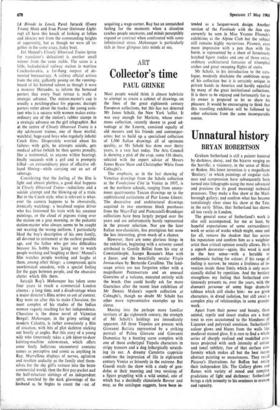Collector's time
ART PAUL GRINKE
Most people would think it almost 'hubristic to attempt to create a cabinet of drawings on the lines of the great eighteenth century European collections, but this has not deterred Mr Janos Scholz, the New York 'cellist. It was easy enough for Mariette, whose enor- mous collection, recently shown to good ad- vantage at the Louvre, consisted equally of old masters and his friends and contempor- aries; but to build up a specialised collection of 1,500 Italian drawings all of optimum quality, as Mr Scholz has done over thirty years, is a rare feat today. The Arts Council is showing a pick of the crop, some 116 sheets, selected with the expert advice of Messrs James Byam Shaw and Christopher White from Colnaghi's.
The emphasis, as in the last showing of Venetian drawings from the Scholz collection at the Fondazione Cini in Venice in 1957, is on the northern schools, ranging from anony- mous quattrocento Tuscan drawings up to the sophisticated caricatures of Pier Leone Ghezzi. The decorative and architectural drawings acquired in two enormous block purchases from the Mayr-Fajt and Piancastelli-Brandegee collections have been largely purged over the years and are unfortunately barely represented in the present selection. Nor are the later Italian neo-classicists, less prestigious but none the less interesting, given much of a chance.
However, there are some glorious things in the exhibition, beginning with a scrawny camel attributed to Gentile Bellini from his stay at Constantinople, Jacopo Bassano's Man with a Spear, and the beautifully secular Virgin lmmacolata by Bernardo Cavallino. The land- scape artists are not forgotten either with a magnificent Pozzoserrato and an unusual Guercino of a volcano, executed entirely with the brush. One could hardly ask for more Guercinos after the recent loan exhibition of Mr Dennis Mahon's superb collection at Colnaghi's, though no doubt Mr Scholz has other more representative examples up his sleeve.
Moving into the perhaps more familiar territory of the eighteenth century, the strength of Mr Scholz's holdings are immediately apparent. All three Tiepolos are present with Giovanni Battista represented by a striking portrait of Palma Giovane and Giovanni Domenico by a hunting scene complete with one of those archetypal Tiepolo characters in stripy trousers and a dog lethargically scratch- ing its ear. A dreamy Canaletto cappricio confirms the impression of life in eighteenth century Venice as leisurely in the extreme. But Guardi steals the show with a study of gon- dolas at their mooring and two versions. of a figure grappling with a wild animal, one of which has a decidedly chinoiserie flavour and may, as the catalogue suggests, have been in-
tended as a lacquer-work design. Another version of the Fortitude with the lion can currently be seen in Miss Yvonne Ffrench's exhibition at the Alpine Club but the subject still remains highly mysterious. Piranesi, even more impressive with a pen than with the burin, is represented by a sheet of ferociously hatched figure studies and one of those extra- ordinary architectural fantasies of triumphal arches and great sweeping flights of stairs.
Mr Scholz, in his introduction to the cata- logue, modestly disclaims the ambitious scope of his collection but it is certainly unique in private hands in America and hardly equalled by many of the great institutional collections. It is there to be enjoyed and fortunately for us its owner is prepared to let us share his pleasure. It would be encouraging to think that this travelling exhibition will be followed by other selections from the same incomparable source.






































 Previous page
Previous page